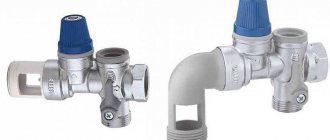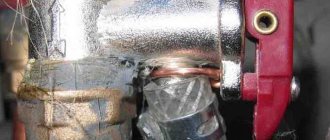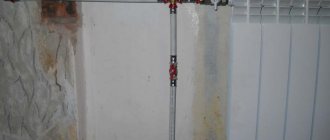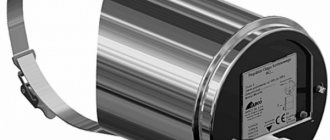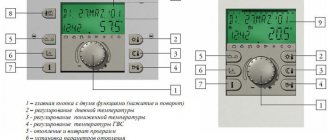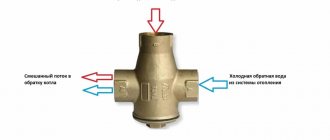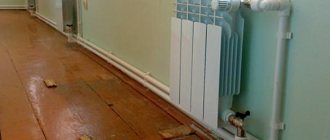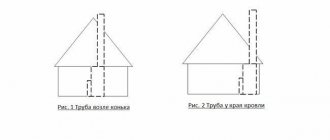Purpose of the hydraulic accumulator
Hydraulic accumulators are used in heating, cold and hot water supply systems.
The main function of a hydraulic accumulator is to accumulate liquid and maintain pressure in the water supply system. To do this, this unit is equipped with a pressure gauge and a relay that maintain a certain interval, at the extreme points of which the pump is automatically turned on and off.
Do not confuse the hydraulic tank and expansion tank. The second is needed in the heating system to compensate for losses during the evaporation of hot liquid, as well as to take on excess air that occurs when heating water in the boiler.
Water hammer is a dangerous phenomenon for plastic pipes. It occurs when the fluid moves in the opposite direction: abruptly closing the tap stops the flow, and it begins to move in the opposite direction, colliding with the wave coming from the pump. At a certain point, too much liquid accumulates in the pipe, which can rupture plastic and even metal. The hydraulic accumulator inhibits the formation of water hammer, as it acts as a buffer between the pump and the point of water consumption.
If the plumbing system of a private home is not equipped with a storage tank, this means that a powerful submersible pump or station will turn on every time someone upstairs opens the tap. The pump resource is limited by the number of on-off cycles, and also has an indicator - the maximum permissible frequency of switching on. On average, the equipment should be turned on 5 times per hour. Constant operation of the unit has much less impact on the parts than frequent switching on. Thanks to the fluid reserve, the hydraulic accumulator can reduce the response rate by 2–3 times, so another of its functions is protection against wear of the electrical part of the pumping equipment.
If the electricity is suddenly turned off, residents can continue to use water in the house as long as pressure is maintained in the hydraulic tank. The operating principle of a hydraulic accumulator for water supply systems is based on the balance of water and air inside the tank.
There are cases when a hydraulic accumulator is not only not needed, but can even harm the pump. We are talking about the constant operation of pumping equipment when watering the garden. In this case, the tank cannot be installed, since the equipment will be turned on and off frequently. When watering, it is better if it works in constant mode - this way the engine overheats and wears out less.
Residents can decide for themselves whether to install a tank or not if the pump is equipped with a soft start system that prevents water hammer.
Types of hydraulic accumulator tanks
Currently, there are a large number of hydraulic accumulators on sale, differing in operating parameters. Among the criteria for their classification are:
- Installation method.
- Volume of storage tank.
- Availability of additional equipment.
- Purpose.
The devices can be mounted in two ways: horizontal and vertical. Relatively small hydraulic tanks are installed horizontally - with a capacity of up to 50 liters. They are placed on a solid surface, with the tank in a horizontal position. Larger hydraulic accumulators are usually hung on the wall on special brackets.
As a rule, the hydraulic tank is red for hot water, and blue for cold water.
According to their purpose, hydraulic tanks are available for cold and hot water supply. Models designed for pumping hot water work in conjunction with large boiler stations and hot water boilers. Through their work, they provide the necessary pressure in the hot water supply system. Only devices that can withstand constant operation at elevated temperatures can be used for these purposes.
Application area
The hydraulic accumulator can be installed not only in a private house, but also in a high-rise building, so that during a water outage in the city, residents have a small supply. This allows you to maintain pressure and use household appliances - a washing machine or dishwasher.
A hydraulic accumulator with a membrane resistant to hot temperatures is used in a hot water supply system as an expansion tank, so when purchasing you need to clarify what function it will perform. A membrane for cold drinking water will not withstand boiling water. The rubber is also different - in hot water supply it is technical, in water supply it is food grade. Hydraulic tanks are connected to a boiler and a double-circuit boiler.
In addition to domestic use, HA is used in many areas of industry, for example, in the engineering industry.
Connection diagrams
How should a water supply system with a hydraulic accumulator be arranged? The answer quite predictably depends on the functions of the latter.
Water accumulation
The tank is connected to the water supply at any point. A check valve is installed at the water supply inlet, which is activated when the pressure in the main water supply drops and prevents the drainage of water in the accumulator.
The tank can be connected at any point in the water supply system
Receiver in a system with a pump
The hydraulic accumulator is connected to the water supply at any point. A check valve is also needed in this case. The instructions for its installation are determined by the type of pump: for a submersible pump it is mounted on the outlet pipe, for a surface pump it is mounted at the end of the suction pipe. In the latter case, it is advisable to install a coarse filter in front of the valve.
Submersible pump system
Pumping station and reserve tank
A fairly common backup water supply scheme, implemented, in particular, in the author’s house, is water supply by a pumping station from a storage tank.
Schematic diagram of water supply with reserve tank and pump
We have already found out why a hydraulic accumulator is needed in this scheme: it stabilizes the pressure in the internal water supply when the pump is turned on and makes its starts less frequent.
Connecting a container and a pumping station has a number of subtleties:
- A float valve (the same as in a toilet cistern) ensures that the reserve tank is automatically filled from the main water supply. The valve is installed in the side wall of the tank just below the lid;
Fill float valve
- The inlet pipe of the pumping station is connected to the insert at the bottom of the tank;
- The area between the container and the pump must have at least the same internal diameter as the suction pipe. Otherwise, it will limit the productivity of the pumping station;
Pay attention to the diameter of the pipe at the pump inlet
- There should be a check valve between the container and the pump. Without it, the water under pressure in the membrane tank will drain back into the container immediately after the pump is turned off;
There is a check valve between the pump and the container.
- The float valve is connected to the water supply inlet. After it (but before inserting the pump pressure line), a second check valve or ball valve is installed. In the latter case, the water supply system switches from the main water supply to the container manually; But when the tap is closed, water will be supplied to the internal water supply only from the container.
Hint: constantly renewing the water in the tank will prevent it from stagnating and acquiring an unpleasant odor.
Fighting water hammer
A membrane tank designed to protect against water hammer is mounted at the water supply inlet, before plumbing fixtures and household appliances connected to the water. In the case of collector water distribution, it is permissible to install it on the collector.
Diaphragm reservoir on the manifold
DHW expansion tank
Designed to compensate for the thermal expansion of water, a membrane tank is connected to the water supply after the boiler or directly in front of it.
In addition to it, the system must contain two more reinforcement elements:
- Check valve in front of the boiler. It will help maintain heated water when the water supply is turned off. The valve is placed in front of the expansion tank;
- Safety valve. It is usually installed immediately after the return tank and duplicates the functions of the expansion tank, dumping excess water at alarmingly high pressure in the water supply. In particular, it will prevent damage to the boiler and pipeline if the elastic membrane of the expansion tank ruptures.
Boiler connection diagram
Boiler safety group - safety and check valves in a common housing
Is it necessary to have a membrane tank in such a system?
No. Excess water may well be released through the safety valve. However, with a significant volume of the boiler, the amount of water discharged into the drainage will be calculated in liters, which is somewhat wasteful.
Types of storage tanks
Membrane storage tank
For domestic needs, two types of tanks are used:
- Membrane. The rubber is secured in a retaining ring. In such a tank, the liquid comes into contact with the walls, but only in one half of the accumulator. The second half is occupied by the air mixture, which can be released or pumped in as needed.
- Balloon. The liquid enters a rubber bulb attached to the neck at the entrance to the tank. Water does not come into contact with the walls and does not affect the metal. On the other hand, there is a possibility of the bulb rupturing and liquid leaking through the nipple. In this model, the membrane can be replaced.
There is also a version without a membrane, but for use in a private house in a water supply system, such a hydraulic accumulator device is inconvenient. The air will mix in the container and leave with the water, so it will have to be constantly monitored and pumped. This needs to be done daily. Membraneless tanks are suitable for storing water for irrigation and outdoor showers.
Models of hydraulic accumulators are produced in vertical and horizontal versions. This is done solely for ease of use. For example, in a small bathroom, the HA can only be installed under the ceiling in a horizontal position, attaching it to the wall. If the technical room is located in the basement, it is better to buy a hydraulic tank with legs and bolt it to the concrete floor.
Types of hydraulic accumulators
Based on such criteria as the installation method, it is customary to distinguish:
- horizontal models;
- vertical models.
Each of them has its own characteristics. First of all, they relate to the method of air removal. When the hydraulic tank is operating, it accumulates around the membrane.
Air dissolved in water is present in any water supply system. When air enters the tank, it is released and accumulates there. Thus, air jams , which can appear in various parts of the system.
To remove these plugs, valve fittings are built into the design of hydraulic accumulators with a capacity of 100 liters or more. This design ensures that accumulated air is removed from the system. It is periodically vented, thereby eliminating the occurrence of air jams.
According to the laws of physics, air accumulates in the upper part of hydraulic accumulators with a capacity of 100 liters or more of the vertical type. Air is removed from there through an air bleed valve, which is part of the hydraulic tank design.
In horizontal hydraulic tanks, air is removed using an additional pipeline assembly. It includes a sewer drain, an outlet nipple and a ball valve.
In a small-volume hydraulic tank, the design does not provide for the installation of such a fitting. These low-capacity devices are purchased by owners of private households because of their compactness. Air is removed from them during a routine inspection when the device is completely empty.
Principle of operation
Balloon hydraulic accumulator
The operating principle of the hydraulic accumulator is based on changes in pressure inside. This happens thanks to additional equipment - a pressure gauge and a relay. The incoming water flow fills the rubber bulb until the pressure rises to the level specified in the settings. Then the sensor is triggered and the pump turns off automatically. In the house, open the tap and use the liquid for domestic purposes until the pressure weakens to the lower specified level. The sensor is triggered again and the pumping equipment is turned on. This is how a hydraulic accumulator works in a water supply system.
When the hydraulic tank is connected to the heating system, it is triggered when the pressure in the boiler increases due to steam during heating. Excess steam is sent to the hydraulic accumulator, from where it can be released if necessary. Fluid loss occurs in the heating system and pressure drops. In this case, the HA gives a signal to replenish the water so that the quality of heating does not decrease.
Design and principle of operation
The name “membrane tank” reflects the principle inherent in this device.
The design is a sealed metal container, the internal space of which is divided into 2 cavities by an elastic membrane.
Water is pumped into one of them (hydraulic chamber)
A pipe with a threaded connection is used to supply water. The pneumatic chamber is equipped with a valve. To automatically control the operation of the pump, a pressure switch is connected to the hydraulic accumulator.
When the pump is turned on, water fills the hydraulic chamber , its volume increases, compressing the air in the pneumatic chamber.
When the air (gas) pressure reaches a critical value, the pressure switch will operate, sending a signal to automatically turn off the pump.
When water is drawn from the accumulator (with the pump turned off), the process develops in the opposite direction:
- compressed air in the pneumatic chamber presses on the membrane, displacing liquid into the line,
- the volume of water in the hydraulic chamber decreases,
- pressure decreases.
When the lower threshold is reached, a command is given to turn on the pump.
Comment! The storage tank does not create water pressure in the system on its own!
Its task is to maintain fluid pressure (created by the pump) until the pump is turned on.
Hydraulic accumulator device
The body is made from various materials - durable plastic, metal or stainless steel. Stainless steel is more expensive, so there are fewer such models on sale. Plastic is also not recommended - it can crack if hit.
The membrane is made of food grade rubber if it is intended for storing drinking water. There is also technical rubber, if it is designed for use for other purposes. The temperature regime of the membrane matters: in hot water systems a heat-resistant one is installed, for cold water - a regular one. This must be taken into account when purchasing a replacement membrane.
A pressure gauge is a device for measuring and regulating pressure. A relay is a sensor that is activated when the lower or upper limit of air compression is reached.
You can bleed air or pump in a new portion through the spool using a bicycle or car pump.
A coarse filter is installed in the housing in case the water contains solid fractions - sand or stones. They can accumulate in the membrane and damage it. The filter is placed in front of the entrance to the rubber bulb.
Hydraulic accumulator maintenance
This is a device that is constantly under pressure and experiences dynamic loads. Therefore, you should always monitor it, in much the same way as you monitor the condition of a car’s tires - before each trip.
Visual inspections for leaks alternate with pressure measurements in the chamber. To do this, at the end opposite the inlet pipe, remove the cover under which the spool is located. Air or nitrogen is pumped through it. Pressure is measured with a car pressure gauge.
A clear sign of a device malfunction is a constant decrease in the amount of pumped atmospheres. Most likely, the integrity of the rubber diaphragm is broken, and air is escaping into the system.
How to replace the battery membrane:
Advantages and disadvantages of a hydraulic tank
Pneumatic hydraulic accumulators have the following advantages:
- affordable price;
- possibility of independent connection to the system;
- simple device;
- replaceable membrane;
- the ability to connect to any type of pump, as well as install several tanks in parallel, so that the operation of the water supply does not stop if one of the accumulators breaks down;
- the ability to select HA of the required volume, but one must take into account that the volume indicated in the instructions is a total number, there will be 2/3 less water in it;
- You can independently disassemble the structure and find the breakdown, as well as carry out repairs and replace parts without calling a technician to your home.
One of the disadvantages is the need for a separate room if the hydraulic tank is large and connected to a surface pump. Such units usually make a lot of noise, so they are isolated from residential premises. When purchasing an inexpensive hydraulic tank, frequent repairs may be required, which entails additional costs.
Criterias of choice
First of all, you need to decide what functions the accumulator will perform. You may need several completely different models - for plumbing, hot water supply and heating. In this case, it is necessary to calculate the required volume of each. Here you cannot do without a specialist who will help you decide.
The next criterion is budget. Imported models are more expensive, but are made of high quality from durable materials, which have a longer service life. If you choose among domestic HAs, you need to choose not the cheapest ones, as they will last longer.
Having decided on the functions and budget, you can proceed to the technical part. Much depends on the quality of the well fluid. If the source does not have a filter installed on the casing pipe, it is necessary to buy a hydraulic tank model with a filter so as not to clog the water supply.
You should calculate the amount of liquid consumed by all family members per day and find out what volume of the tank should be installed. A reserve should be provided in case you need to purchase any household devices or build a bathhouse. For a family of 4 people living in a house, you need a 50 liter tank. At the same time, the house has a washing machine, shower, bath and faucet in the kitchen. A specialist can calculate the optimal volume of HA using a special formula, which includes the maximum permissible number of inclusions, lower and upper pressure indicators, and maximum water consumption per hour.
It must be taken into account that unused liquid stagnates and may smell like sludge, so a tank that is too large is not needed.
How to choose a suitable hydraulic tank
When choosing a device, you should clearly determine what the hydraulic accumulator is needed for and what functions will be assigned to it. First of all, you need to calculate the peak water flow in the house, selecting a device depending on this.
You can independently calculate the required hydraulic tank performance using the following formula:
V = A x k x (P max + 1) x (P min + 1) / (P max – P min) x (P air + 1), where
V is the required tank volume.
A is the peak water flow in the house per minute.
P max, P min – maximum and minimum pressure created by the device.
R air – air pressure in the tank.
K is a coefficient whose values are different for devices of different power. The coefficient indicators are shown in the table below.
| Pump power, kW. | 0,55 – 1,5 | 2,20 – 3 | 4 – 5,5 | 7,5 – 9 |
| Coefficient | 0,25 | 0,375 | 0,625 | 0,875 |
After carrying out the calculations, it is recommended to make an upward correction in case of an unexpected increase in water consumption. For example, if it turns out that the tank volume required for your home is 33 liters, then it is better to buy a water battery with a capacity of 35-40 liters. But you should also not purchase an overly large tank: the water in it will stagnate, as a result of which its taste will deteriorate and a musty smell may appear.
For cold and hot water supply you need to buy separate models. You can distinguish water pumps by purpose by the color of the tank. Models for cold water supply are standardly painted blue, and for hot water - red. But sometimes there are devices that do not have an identifying color, for example with a silver tank. In this case, before purchasing, you must read the instructions from the manufacturer, which should indicate for what purpose this device is intended.
Installation and connection
Connection diagram to a deep-well pump
You can use your own skills and experience for installation. All connection steps are described in the instructions. The upper and lower pressure thresholds are pre-set. You can leave the factory settings, where the lower limit is 4 bar, the upper limit is 8 bar. If the system does not work correctly, the settings are changed by tightening the large and small springs.
The tank is placed after the pump, connected using a fitting with three and five inputs. Two of them are for relays and pressure gauges, the rest are for pipes and flexible hoses to reduce vibration transmitted from the pump.
Before starting, use a pressure gauge to check the pressure of the air mixture inside again. Then you can turn on the system. If the relay operates correctly, the installation process is completed and the water supply can be operated.
Features of operation
During operation of the hydraulic accumulator, the following rules must be observed:
- check the pressure 2 times a year, if necessary, more often by pumping in a new portion or bleeding off excess;
- monitor for leaks - they may indicate a rupture of the rubber membrane and the need for replacement;
- monitor the operation of the pump - its frequent switching on also indicates that the accumulator is not working correctly due to settings or breakdowns.
The less often the pump turns on, the better. The maximum number of starts should not exceed 30 times per hour.
If it turns out that one hydraulic tank is not enough, you can build in one more or even several. In this case, the system will function if any of them breaks down.
